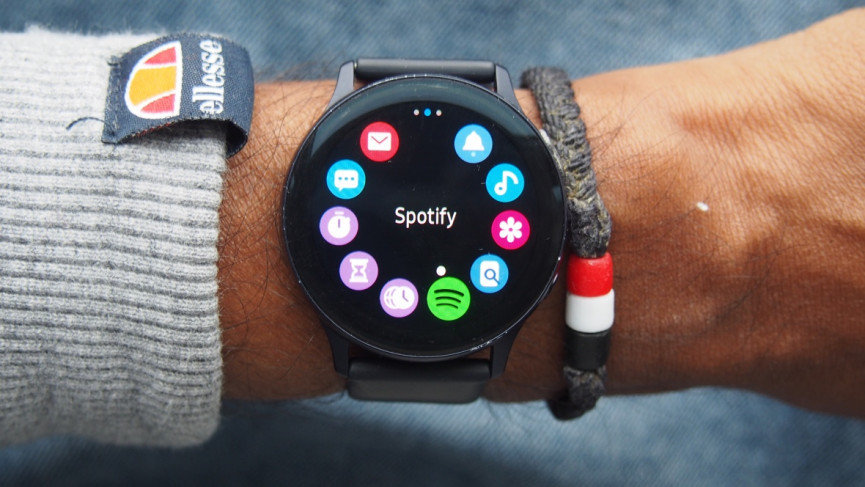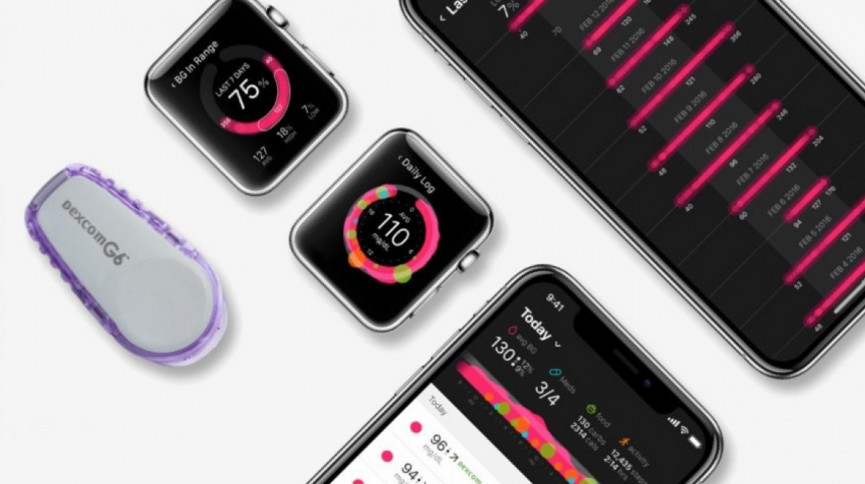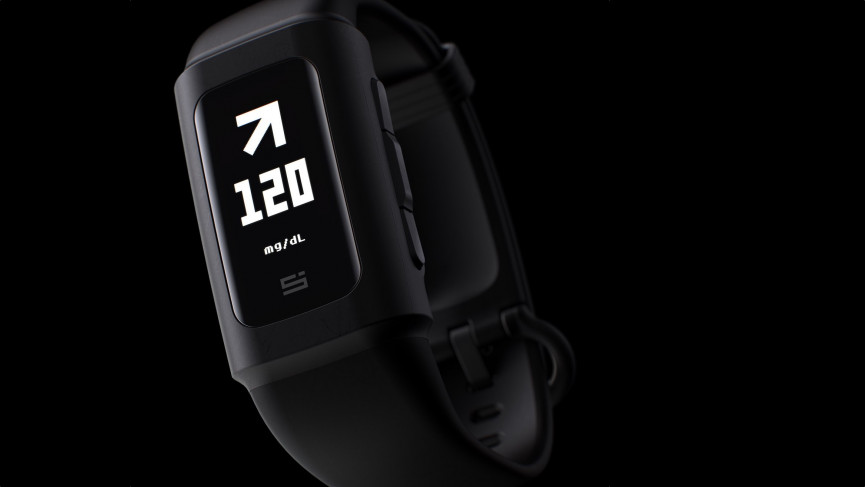
Whether it's the Apple Watch using ECG to highlight serious health issues or the Samsung Galaxy Watch helping you keep tabs on your blood pressure, wearables have come a long way from step tracking.
The likes of Apple, Fitbit and Samsung now talk about their wearables as health monitoring devices, and while some features on offer still lack the regulatory approval to offer data on par with medical devices, things are changing.
Essential reading: How to use ECG on the Apple Watch
We've now seen ECG, a pulse oximeter and skin temperature sensors appear on smartwatches but there's one type of sensor and biomarker we haven't seen yet and that's non-invasive glucose monitoring.
Right now, there are devices dedicated to glucose monitoring that can be connected to smartwatches and smartphones to provide that data. Currently, there isn't a smartwatch that can offer that feature on its own.
It's a feature that would be welcomed by diabetics, with the International Diabetes Federation claiming over 700 million people will live with diabetes by 2045. This is not just about diabetes either. It can offer useful insights into general health, allow for better remote monitoring for parents keeping an eye on their children's glucose levels, or even for endurance athletes wanting to build the right kind of nutrition fuelling for training.
So why is it a big deal to build a smartwatch that offers the ability to non-invasively monitor blood glucose levels? How is it possible and when could we see the first Apple Watch, Samsung or Fitbit smartwatch that could make it a reality? Here's the key developments on bringing glucose monitoring and wearables closer together.
Helping 700 million people

Dexcom sensors can pair with Apple Watch – but still require invasive tracking
For diabetics, getting real time blood sugar data is something of a Holy Grail. But blood glucose data can be a big deal for genera health too.
Picture a scenario. You're wearing a Fitbit or Apple Watch and you're pretty thirsty. So you get yourself a soda and start drinking. All of a sudden, your smartwatch sends you a notification. It's detected a massive intake of sugar, and you all of a sudden see your glucose levels in real time, soaring after inhaling 39g of the sweet stuff.
That's the big sell with glucose monitoring: once you can see what sugary foods do to your body in real time maybe you'll be less likely to reach for a soda, donut or cookie, the next time you get a craving.
That's the big sell with non-invasive continuous glucose monitoring. It would essentially track your glucose levels like wearables track your heart rate now. You'd have a daily, minute-by-minute break down throughout your day.
The level below that is just non-invasive glucose monitoring. This would allow something like a fitness tracker to track your glucose, but not all the time. Perhaps at hourly intervals. It would be nice, but it's not as groundbreaking as continuous glucose monitoring.
Let's also not forget that there are around 100 million Americans living with diabetes. Non-invasive glucose monitoring would be a major quality-of-life upgrade, saving the time-consuming and unpleasant prick on the finger, and carrying around a testing kit.
Why is it so difficult to non-invasively monitor blood glucose?

Fitbit recently added the ability to add manual glucose readings to its companion app
Traditionally, the process of monitoring blood glucose involves drawing blood to take a measurement or uses a sensor embedded under the skin to reveal blood sugar levels in real time.
These are parts of the process that companies are seeking to find a solution and to take that invasive element out of the equation. These solutions seem to revolve around a similar optical based method that's already been put to use for measuring heart rate, blood oxygen and body temperature.
Jake Leach is chief technology officer at Dexcom, the company responsible for a FDA approved sensor that's worn just underneath the skin that continuously monitors glucose levels and can display data in real time to devices like the Apple Watch. Dexcom is currently working on the seventh and eighth generations of its device.
"Measuring glucose non-invasively is really challenging, and the challenge is being able to do it reliably and accurately," Leach tells us. "In the multiple decades that I've seen, non-invasive development occurring, there just hasn't been a technology that can provide the level of accuracy that we can provide with sensors that are in actual contact with glucose and an electrochemical sensor."
Leach doubts the accuracy needed can be delivered by a non-invasive device, though doesn't rule out some innovation happening that can make the process of monitoring glucose levels a simpler one. "One of the interesting things that's been talked about as well is maybe it doesn't have to be that accurate," he says.

"If you actually look at the changing glucose of a healthy individual, you're looking for small changes in glucose that you're trying to optimise around and learn how food, diet and exercise can impact on glucose levels. It may actually need to be just as accurate, maybe even more."
It's one thing to be able to do non-invasive continuous glucose monitoring, it's another thing to be able to do it so well it can help advise on insulin dosage for those with diabetes.
While the first bit could be possible, it would have to be able to advise on dosage to be used as a reliable medical device for people with diabetes. Valencell CEO Steven LeBoeuf told Wareable that that's pretty much impossible.
"There will literally be stem cell regenerated pancreas cells in the body before there is ever anything that can be a truly noninvasive glucose monitor for dosing insulin," he said.
The problem? The laws of physics. You just can't draw that much data from things like interstitial fluid and need a real drop of blood, which requires a pricked finger.
However, LeBoeuf also says that other methods – for non-diagnosing reasons – are actually working well. In fact, research by big companies like Apple may help others advance the technology.
How are the big players trying to make it a reality?
So how are the companies making smartwatches and fitness trackers trying to solve this problem of delivering non-invasive glucose monitoring from the wrist? Some have been more open about their ambitions than others to make it possible, while there's been speculation aplenty about others that this is something they are putting the research hours into.
Apple

The biggest player in the game is obviously Apple, which has been rumoured to be interested in glucose monitoring since before the Apple Watch was even a thing.
In fact, CEO Tim Cook was rumoured to be testing out a continuous glucose monitoring device before the Series 3 arrived on our wrists. It's believed to brought on a team of scientists to help deliver the major breakthrough for wearables.
In 2018, Apple was granted a patent for technology that sounds a lot like potential non-invasive glucose monitoring. It uses a light-based optical monitor that measures substance in blood and then sees how it changes. Basically, checking your blood for glucose.
More recently, there was speculation that an Apple Watch that can track blood glucose was in the works and that Apple was testing “reliability and stability” of the functionality before a launch.
It's also been recently revealed that Apple secured a deal with UK startup Rockley Photonics who builds optical based sensors that promise to deliver blood glucose data. So the evidence is mounting even if Apple hasn't explicitly said this is something it's planning for a future Apple Watch. Rockley has also made a reference wearable that it says is capable of taking glucose readings.
And the most recent rumors are that Chinese companies Ennostar and Taiwan Asia Semiconductor are developing the sensors, which are reported to be infrared, which use “wavelengths above 1,000 nm” and a photodiode to interpret blood glucose levels.
This could arrive for the Series 8 – if Apple can get through the FDA, which does seem unlikely.
Samsung

Apple's big rivals Samsung want in on the holy grail too. It's already managed to provide ECG and blood pressure monitoring data with the latter needing to be calibrated with a dedicated blood pressure monitor every few weeks.
The same source that pointed to Apple looking at the feature also claimed a Samsung Galaxy Watch that tracks blood glucose might land in 2021 – although those rumors have been quashed recently.
Apparently the sensors have been developed in conjunction with MIT, and unlike Apple, these are the first rumors that have really surfaced that Samsung could be planning this kind of monitoring support on its wearables.
Fitbit

Before Google acquired Fitbit, the smartwatch and fitness tracker was already making moves to further explore the possibility of monitoring glucose from its devices.
It partnered up with One Drop to bring diabetes management to Fitbit smartwatch owners. There was also a UnitedHealthcare partnership, which is a pilot program that saw people given a Fitbit and Dexcom monitor to see how activity impacts their diabetes.
Fitbit's biggest stake in diabetes though was its $6 million investment in Sano. This is a company that's working on a painless, coin-sized patch that can track your glucose. The way it works is that it reads the interstitial fluid just under your skin, which doesn't involve any pain to get a reading.
The company also added the ability to manually track glucose readings in its app – which feels like a precursor to some kind of native wearable functionality – even if it's invasive.
And finally, it's launched partnerships with Lifescan, which would see data from the company's connected glucose monitors be automatically added into the Fitbit app.
Alphabet

Google parent company Alphabet and its Verily research division secured a partnership with Dexcom to work on a continuous glucose monitoring sensor.
Leach gave us an update on the progress of the partnership, which is still very much in the works: "The device is embodied in our G7 product that's not been available commercially", he told us. "It was about miniaturising that platform and making the wearables smaller on the body so it's more convenient and more comfortable to wear.
"That relationship resulted in some electronics that allowed us to further miniaturise from where we are with the G6, to where we're going to with the G7, which is 60% smaller. So a huge leap in innovation there."
Wearable glucose monitoring devices available right now
Freestyle Libre 2
Price: , Freestylelibre.com

The Freestyle Libre wearable places sensors just below the skin reads the interstitial fluid to produce readings. A coin-shaped pod sits on top of the skin and uses NFC to tap your phone against it to generate glucose readings that are stored in the companion app.
The sensors can display a current reading, data for the last 8 hours and the ability to see how your levels are trending. It lasts for up to 14 days before you need to replace it with a new sensor to continue tracking.
You can read how we got on living with the Freestyle Libre wearable.
Supersapiens
Price: subscription, supersapiens.com

Developed by the Abbott, the same company behind the Libre 2, Supersapiens is designed for endurance athletes to better understand fuelling for training and competition.
Its glucose sport biosensor wearable device is very similar to the Libre 2 that sits underneath the skin and uses the same NFC method to transmit data to the companion app.
Launched the Energy Band (pictured above), that will enable you to glance at your data without reaching for your phone. With the current setup, you can see glucose data in real-time and help give you a better sense of the type of fuel you use to power workouts is most effective. It's currently available on a monthly subscription service or 3 and 6 month training packs.
Dexcom G6
Price: , dexcom.com

As already mentioned, the G6 is Dexcom's most recent wearable glucose monitor is FDA approved and can continuously monitor glucose over a 10-day period from a single sensor.
It uses Bluetooth to share data to Android phones and iPhone and also offers support for wearable devices like the Apple Watch to view data. It can send alerts when glucose levels are low and is suitable for ages 2 and above making it suitable for children and adults to wear.
And Garmin has also added a Connect IQ app for Dexcom G6 users, so glucose data will be absorbed into the Connect app.
How we test
